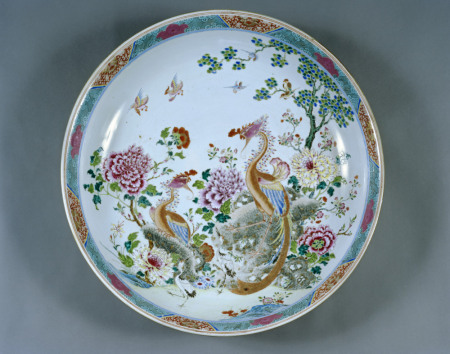Emile de Bruijn, Registrar at the National Trust, is a heritage professional who uncovers many of the hidden gems found throughout the vast Trust collection. He documents and posts his latest findings through his blog National Trust Treasure Hunt. Emile has agreed to let Royal Oak share his posts here, on AngloFiles for you, our members. Sign up for Emile’s emails on his blog to stay connected with the latest findings in the National Trust’s collection.
Enjoy below Emile’s descriptions of select Asian heirlooms.
By Emile de Bruijn

Chinese porcelain dish decorated with phoenixes and peonies, about 1750, one of a pair, at Melford Hall, NT 926292. ©National Trust Images/John Hammond
I just spotted this image of a rather nice Chinese porcelain dish at Melford Hall, Suffolk, showing a pair of phoenixes. They are perched on rocks and surrounded by peonies. In Chinese art the phoenix – called ‘the king of birds’ – is often associated with the peony – similarly called ‘the king of flowers’.

Large Chinese porcelain lidded jar decorated with a phoenix among peonies, about 1745, one of a pair, at Melford Hall, NT 926279. The vases were among the cargo of the Spanish galleon Santissima Trinidad captured by Captain Sir Hyde Parker, 5th Baronet, off Manila in 1762. ©National Trust Images/John Hammond
A pair of large Chinese lidded vases also at Melford is decorated with similar scenery. Apart from the odd scale of some of the elements of the design (the huge peonies on the dishes and the tiny fences on the vases, the mythical phoenixes are painted with the same level of detail as the other fauna and flora, making it seem as if you could readily encounter them in Chinese gardens.

Phoenix among peonies, with a magpie and a duck, on the Chinese wallpaper in the State Bedroom at Nostell Priory, NT 959651. ©National Trust Images/Dennis Gilbert
A similar mythical phoenix in a similarly realistic setting turns up in the Chinese wallpaper at Nostell Priory.
There is a long tradition in Chinese art of combining myth and reality. This is connected to the symbolic meanings attached to all sorts of plants and animals: if everything is imbued with symbolism, then there is no fundamental difference between reality and myth.
I have just been made aware of a new book about this subject, The Zoomorphic Imagination in Chinese Art and Culture, edited by Jerome Silbergeld and Eugene Y. Wang (University of Hawai’i Press), which I am looking forward to reading.



